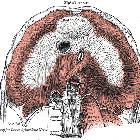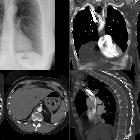Bochdalek'sche Hernie













Bochdalek hernias , also known as pleuroperitoneal hernias, (alternative plural: herniae) are the commonest type of congenital diaphragmatic hernia. They occur posteriorly and are due to a defect in the posterior attachment of the diaphragm when there is a failure of pleuroperitoneal membrane closure in utero. Retroperitoneal structures may prolapse through the defect, e.g. retroperitoneal fat or left kidney.
Clinical presentation
Large hernias typically present in infancy, are usually said to be most frequently left-sided, presumably owing to the protective effects of the liver, although recently this has been disputed, at least in adults . The left opening of the posterior diaphragm closes later in fetal life than the right which may also contribute to the asymmetric occurrence. Complications are usually due to pulmonary hypoplasia.
In adults, incidentally-discovered posterior diaphragmatic hernias are rare (0.17% of patients having an abdominal CT). Of these, right-sided hernias are more common (68%), and more frequent in females. The great majority are small, with only 27% containing abdominal organs such as bowel, spleen, or liver.
Radiographic features
Plain radiograph
On conventional radiographs, the hernia may appear as a lung base soft-tissue opacity lesion seen posteriorly on lateral images.
CT
CT usually demonstrates fat above the diaphragm and is extremely beneficial in revealing organ entrapment. Coronal and sagittal reformatted images show the defect to best advantage.
Differential diagnosis
- Bochdalek herniae may mimic diaphragmatic rupture from trauma, but you would expect to find other supportive signs of chest and/or abdominal trauma.
History and etymology
Vincent Alexander Bochdalek (1801-1883) was a Czech anatomist and pathologist .
Practical points
BBBBB is a simple mnemonic to recall the features of Bochdalek hernias.
See also
Siehe auch:
- spleen
- Bauchwandhernien
- Leber
- Zwerchfellhernie
- Zwerchfell
- Lungenhypoplasie
- Morgagni-Hernie
- Morgagni-Larrey hernia
- bochdalek hernia features (mnemonic)
- BBBBB
- Bochdalek'sche Hernie mit intrathorakaler Niere
und weiter:

 Assoziationen und Differentialdiagnosen zu Bochdalek'sche Hernie:
Assoziationen und Differentialdiagnosen zu Bochdalek'sche Hernie:






